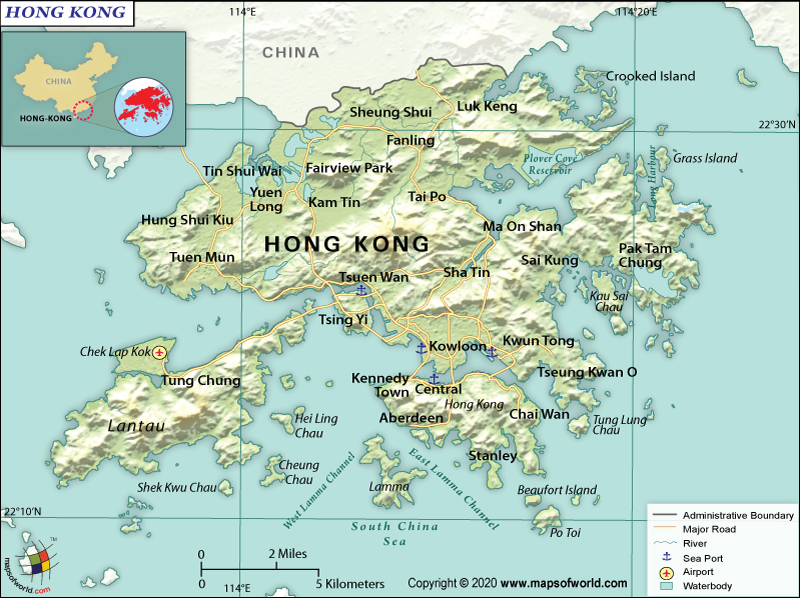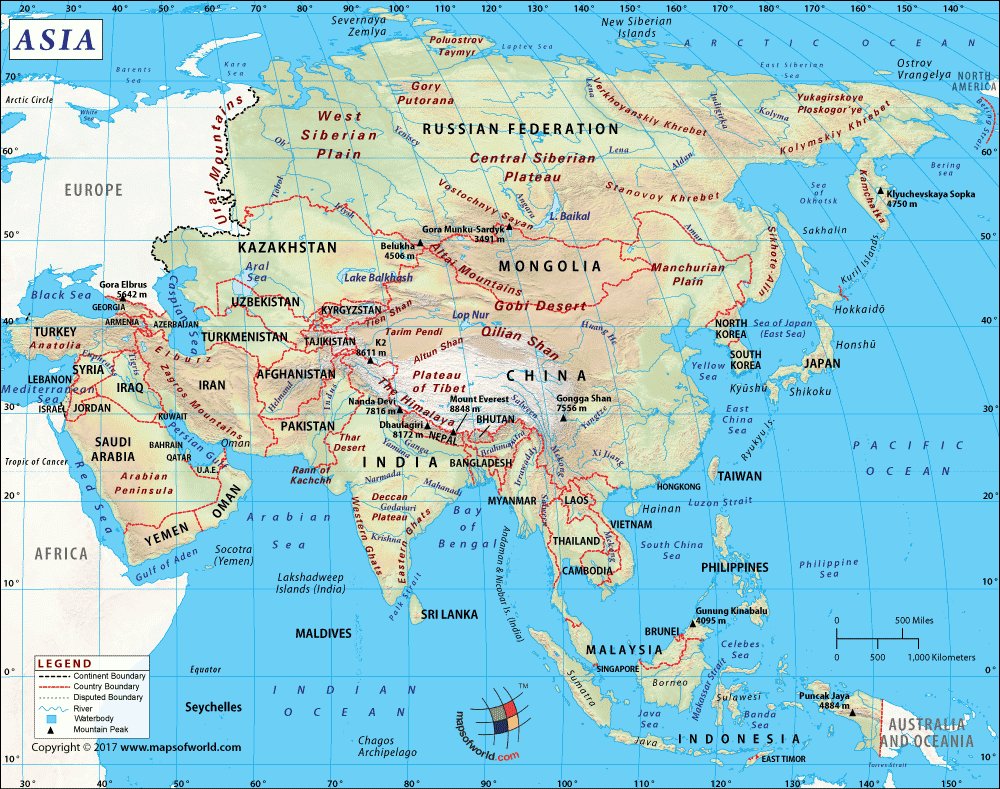What are the Key Facts of Hong Kong SAR, China?

|
Official Name |
Hong Kong Special Administrative Region |
|
Continent |
Asia |
|
Coordinates |
22.281099, 114.175311 |
|
Area |
428 sq. mi ( 1,108 sq. km) |
|
Land Boundaries |
21 mi ( 33 km) |
|
Coastline |
455 mi ( 733 km) |
|
Currency |
Hong Kong dollar (HK$) (HKD) |
|
Population |
7,482,500 (2018 est.) |
|
Official Languages |
Chinese (majority Cantonese), English |
|
Major Religion |
Buddhist or Taoist |
|
National Day |
1 July (Hong Kong Special Administrative Region establishment Day) |
|
National Anthem |
“Yiyongjun Jinxingqu” |
|
Form of Government |
Special administrative region of the People’s Republic of China |
|
President |
Xi Jinping (President of China) |
|
Chief Executive |
Carrie Lam |
|
GDP per capita (PPP) |
$ 64,487.6 (World Bank, 2018) |
|
GDP per capita (nominal) |
$ 48,717.3 (World Bank, 2018) |
|
HDI |
0.933 (2017), Rank: 7 |
|
Literacy Rate (%) |
NA |
|
Space Agency |
China National Space Administration (Space agency of China) |
|
Military Expenditure Ranking |
China’s rank: 2 (SIPRI, 2017) |
|
No. of Olympic Medals |
3 (as of 2018) |
|
Driving Side |
left |
|
Calling Code |
+852 |
|
Time Zone |
UTC+8 (Hong Kong Time) |
|
Internet TLD |
.hk |
Where is Hong Kong?
Hong Kong (a special administrative region of China) is located in southern China’s eastern side of the Pearl River estuary. It is located 60 km (37 mi) east of Macau. This Chinese region in the southern coast of China shares its border with Shenzhen city of Guangdong province along the Sham Chun River (to the north) and with the South China Sea (to the south, east, and west directions).
What is the Geography of Hong Kong?
The special administrative region of Hong Kong has 3 territories including Kowloon, Hong Kong Island, and the New Territories. This major coastal port city has 263 territorial islands as well as peninsulas including Hong Kong Island, Peng Chau, Lamma Island, Cheung Chau, Lantau Island, and Tsing Yi Island. All these islands are located in the Pearl River Delta.
To enumerate, the total area of Hong Kong is 1,108 sq. km (428 sq. mi), out of which 1,073 sq. km (414 sq. mi) is land area and 35 sq. km (14 sq. mi) is water area. While the regional border is 33 km (21 mi) long, the coastline is 733 km (455 mi) long.
In fact, the terrain of this region is mountainous and hilly, characterized by steep slopes. In the northern part of the special administrative region, lowlands are situated. While Tai Mo Shan is the highest elevation point of Hong Kong at 958 meters (3,143 ft), the sea level at South China Sea is the lowest elevation point.
Of the sixty islands around this region, the one having the largest area is Lantau Island. This island is situated in the southwest location of the main peninsula. All these islands are part of the New Territories, including the hilly terrain that is located in the north direction of Kowloon. Victoria Harbor separates the Hong Kong Island. In the northwest part of the New Territories, the landforms are basically lowlands in nature.
Major peaks of Hong Kong are Tai Mo Shan, Fung Wong Shan (Lantau Peak), Tai Tung Shan (Sunset Peak), Sze Fong Shan, Yi Tung Shan, Nei Lak Shan, Lin Fa Shan, and Ma On Shan. While Pearl River is the main river of Hong Kong, the major lakes are Bride’s Pool, Po Chu Tam, Mirror Pool, and Inspiration Lake.
Further, the climate of this region is subtropical and monsoonal is nature. While the winters are cool and dry, the summers are hot and wet. Tropical cyclones take place during May-November (especially from July to September). During winter seasons (especially in January and February), the mean temperature revolves around 16°C (60.8 °F). During the months of July and August, the average temperature remains around 28°C (82.4 °F).
The climate generally remains cloudy in the months of January and February. During this time, occasional cold fronts are accompanied by dry northerly winds. In the New Territories as well as the high grounds, at times sub-zero temperatures and frost also occur. Sometimes in the urban areas, the temperature also drops below 10°C (50 °F). The most pleasant climatic conditions prevail during March and April. These months are characterized by occasional spells of high humidity.
The high ground area that remains exposed to the southeast direction gets fog and drizzle. During May-to-August, the climate remains hot and humid with occasional thunderstorms and showers. While the afternoon temperature generally remains above 31°C (87.8°F), nighttime temperature revolves around 26°C (78.8 °F). High humidity is common. During November-to-December, Hong Kong gets plenty of sunshine, the temperature remains comfortable, and the breeze blows pleasantly.
What is the Economy of Hong Kong?
To begin with, this region has a service-oriented economy. The economy is characterized by low taxation, a well-established international financial market, and almost free port trade. Hong Kong Dollar (HKD) is the currency of this special administrative region. HKD is pegged to the US Dollar and is issued by 3 major international commercial banks. Though Hong Kong Monetary Authority works as a financial regulatory authority, there is no officially recognized central banking system in Hong Kong.
In particular, the nominal GDP of Hong Kong was US$ 362.99 billion in 2018. This region has the highest degree of economic freedom in the world. The economy is highly dependent on international trade and finance. All these factors, along with ease of doing business, make Hong Kong one of the most favorable places for starting a company. The number of registered start-ups in this special administrative region of China has increased from 998 in 2014 to 2,800 in 2018. Most of these start-ups are eCommerce, Software, Fintech, and advertising companies.
Moreover, the greatest strengths of this region are a sound banking system, huge foreign exchange reserves, almost no public debt, a strong legal system, close economic ties with mainland China, and stringent anti-corruption measures. Hong Kong Stock Exchange (HKSE) is a favored exchange for listing firms from abroad and mainland China. In terms of size, available financial tools, and regulations, HKSE can be compared with stock exchanges of New York and London. HKSE is the 6th largest stock exchange in the world.
Additionally, Hong Kong has the 7th largest port (in terms of container throughput) in the world. The Kwai Chung container complex of Hong Kong is the largest in the entire Asia. This region has a highly skilled labor force, ensuring maximization of investment, external trade, and employment for advanced and technology-based works.
July 2019 figure shows that the labor force in Hong Kong is 39.83 million (Census and Statistics Dept, Hong Kong government). Over 90% of the labor force is engaged in services sector (including trade, hotels, restaurants, insurance, finance, transport, communications, social services, and many more). Only 1% of the workforce was unemployed in July 2019.
However, Hong Kong is one of the most expensive cities in the world. Official figures of 2018 show that the total number of people living below the line of poverty here is over 1.37 million. There is extreme inequality in this region. While 1-in-5 people live under poverty, 1-in-7 people are millionaires. The housing prices in this region are also soaring to stratospheric levels, with people living in ‘cages’ and ‘coffins’ stacked on top of one another.
What is the Transportation System of Hong Kong?
The transport system (including public and private transport) here is highly developed as well as sophisticated. More than 90% of daily passengers commute on public transport (buses, minibuses, trains, trams, and ferries), which is the highest in the entire world. 2017 figures show that there are 2,107 km (1309 mi) of total roadways available in Hong, and all of them are paved ones.
Unusual transport systems such as zero-fare escalators as well as moving pavements can be found in the central and western districts of Hong Kong. The longest covered escalator system in the world is present in Hong Kong and it is known as Mid-levels Escalator. It consists of 20 escalators as well as 3 moving pavements. These unique elevators are 800 m (2,625 ft) long and climb a vertical height of 135 m (443 ft).
An extensive railway network system is present in this region. It is the backbone of the public transit system of the region. MTR Corporation operates the public transport trains. Metro network and tram services are also extensively used in the inner urban areas of Hong Kong, the main business districts, and the New Territories. All the MTR trains and most of the MTR stations are air-conditioned.
Hong Kong is a major seaport. There are 2,615 merchant marine ships available in this special region. It includes 1143 bulk carriers, 499 container ships, 217 general cargo ships, 355 oil tankers, and 401 others.
What International Organizations is Hong Kong part of?
WTO, ADB, IMF, APEC, BIS, FATF, IHO, IOC, UPU, WCO, WMO, ICC (national committees), ITUC (NGOs), Interpol (sub-bureau), IMO (associate), UNWTO (associate), ISO (correspondent)
Related Link:



